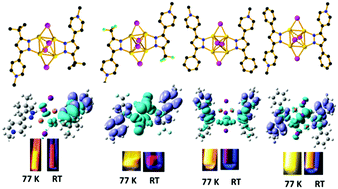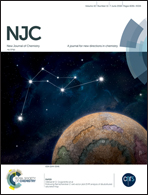Substituent regulated photoluminescent thermochromism in a rare type of octahedral Cu4I4 clusters†
Abstract
A series of Cu4I4 clusters (1–5) supported by two pyrazolate-type zwitterionic ligands N-methyl-[4-(5-R-pyrazolyl)]pyridinium (1: R = tert-butyl; 2: R = trifluoromethyl; 3, 4, 5: R = phenyl) have been prepared and fully characterized. These compounds all exhibit a distorted “octahedral” geometry and their luminescence behavior is quite distinct from those of previously reported tetranuclear copper halide clusters. The crystalline powders of all five clusters only show a single broad low-energy (LE) emission band from 300 to 80 K. Cluster 1 shows temperature-independent orange phosphorescence despite a slight blue-shift of the low-energy flank upon cooling. Intriguingly, for clusters 2–5, a hypsochromic phenomenon is clearly observed by decreasing the temperature. Using DFT/TDDFT calculations, we find that the nature of the electronic transitions responsible for the LE emission is dominated by the steric demand and/or electronic characteristics of the substituents on the pyrazolyl moiety. Specially, contribution of cuprophilic interactions in the lowest triplet excited states is ruled out by the rigid ligands. The single LE emission of 1 and 2 is attributed to pure 3ILCT and 3(M + X)LCT transitions, respectively, while the emission of 3 and 4 is assigned to a mixed 3ILCT and 3(M + X)LCT transition with different proportions.



 Please wait while we load your content...
Please wait while we load your content...